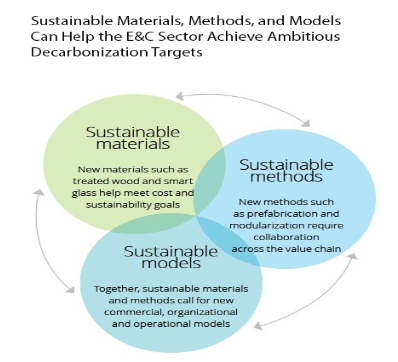In case you missed it see what’s in this section
Let's Talk
4 Sustainable Construction Methods
A new study has shown that by 2030, worldwide energy measures could save up to $410 billion and up to 7.6 TWh of electricity. Widespread adoption of sustainable construction methods has the potential to reduce the building sector’s carbon footprint.
Innovative new building materials and methods, policy support and regulation can contribute massively to the decarbonisation of the construction industry. In this blog, we will explore six sustainable construction methods that can be effectively incorporated into the construction of new buildings to minimise environmental impacts.
So, let us take a look.
Sustainable Construction Methods
!. Lean Construction
It is an integrated systems method that focuses on minimising waste and optimising the project construction. The goal of lean construction is the short-term reduction of waste and efficient use of resources. The construction equipment is assembled using fewer resources and has a lower environmental effect.
Sustainable construction companies widely use this method of construction to increase the efficiency of their weekly work planning and early stakeholder engagement.

Source: Deloitte Analysis
2. Prefab, Modular and Industrialised Construction
Prefabrication is a technique that is used in industrialised construction. Standardised building systems, complex assemblages and repetitive subcomponents of a building are the key elements of this method of construction.
Prefabrication offers a number of benefits, such as:
- It can lead to reduced labour costs as it simplifies the installation process and reduces the requirement of workers onsite for project completion.
- Prefabrication reduces the time spent by the labourer on site. The controlled factory environment has a lesser scope for hazards, which contributes to improved safety.
- It minimises the necessity for coordination among subcontractors because electrical, ductwork and other components are installed within the wall. There is no delay due to weather conditions, and shift work can take place without any hindrance.
- One of the major advantages of prefabrication is improved quality of the finished product as the work is done under controlled and enclosed spaces, allowing for greater quality control.
3. Using sustainable construction materials
Sustainable building materials are gaining traction as they provide an effective option for reducing environmental impact. Various materials, ranging from bamboo to recycled steel, can create energy-efficient buildings, reduce wastage and conserve valuable resources.
Some of the sustainable construction materials that are frequently used by construction industries are:
- Bamboo: It is a major part of the green building industry and has proved to be an effective alternative to timber. It is lightweight, has sound barrier properties and exhibits natural resistance to moisture.
- Hempcrete: It is a lightweight, natural composite material that is environmentally friendly and acts as a natural pest repellent.
- Cork: It is an insulating material that has fire-resistant properties. It offers comfortable and unique aesthetics.
- Recycled Steel: Steel is strong, durable and can be recycled multiple times without losing its sustainable properties.
- Reclaimed Wood: It acts as a good, sustainable building material that eliminates the need for additional resources.
- Clay: It has fire and pest-resistant properties. It is affordable, versatile and energy efficient, making it an ideal material for cooler temperatures.
4. Circular Construction
The circular economy is a system in which the raw materials and products are reduced, reused and recycled as long as possible. The construction industry contributes to as much as 40% of Carbon Dioxide emissions. This can be effectively tackled through the application of circular construction methods.
It offers a range of benefits such as reduced Carbon emissions and energy efficiency–effectively reducing the carbon footprint of the construction industry, financial benefits to the businesses through decreased raw material requirements and social benefits through the creation of job opportunities.
Wrapping Up
According to the United Nations Environment Programme (UNEP), the construction sector accounts for 37% of global carbon dioxide emissions. Using sustainable construction methods can effectively diminish the negative externalities of the construction process.
Hopefully, this was helpful.
Weather in Swindon
Listings




















